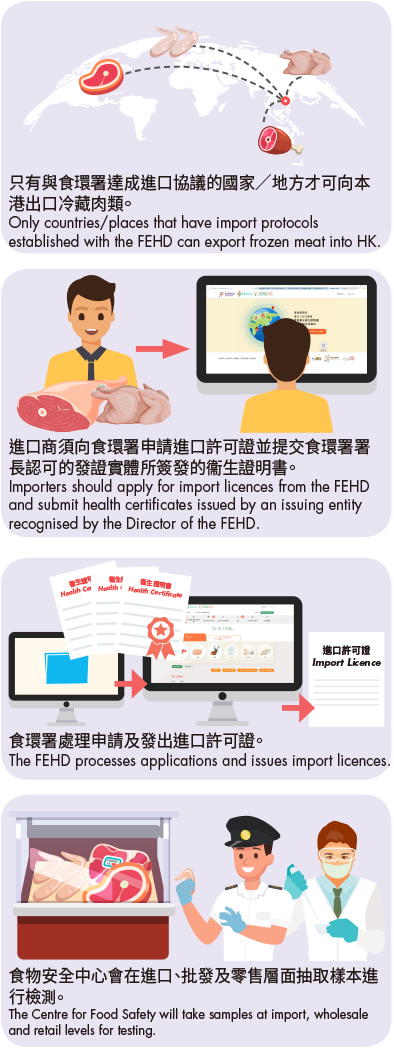
Food Safety Focus (166th Issue, May 2020) – Incident in Focus
Frozen Meat: Tips for Food Safety
Reported by Ms. Melva CHEN, Scientific Officer,
Risk Communication Section, Centre for Food Safety
The coronavirus disease 2019 (COVID-19) pandemic sees an increased demand for frozen foods such as meat and poultry for many families. Part of the reasons are that they have longer shelf lives and can be stored in a freezer for later use. This article will pinpoint some food safety issues of frozen meat.
How is Frozen Meat Regulated in Hong Kong?
Frozen meat mainly comes from Brazil, mainland China, the USA, Canada and the Netherlands etc. Locally, there are specific legal requirements for the import of meats including frozen meat. Regulation 4(1)(a) of the Imported Game, Meat, Poultry and Eggs Regulations, Cap. 132AK, requires meat or poultry to be imported with a health certificate issued by an issuing entity recognised by the Director of the Food and Environmental Hygiene Department (FEHD). Under the Import and Export Ordinance, Cap. 60, import of meat and poultry is subject to import licensing control. The FEHD is responsible for issuing import licences for these foods. Moreover, importers are obliged to source meats from reliable suppliers, obtain health certificates, apply for import licences and ensure the meats are fit for human consumption. Besides import control, like all other food sold on the market, routine surveillance and testing are in place at import, wholesale and retail levels.
Figure 1: Regulation Regime of Frozen Meat
Issues on Buying and Storing Frozen Meat
Consumers should patronise hygienic shops that display frozen meat for sale in the freezer cabinet kept at -18°C or below, the temperatures that stop bacteria growth. For prepackaged frozen meat, check the expiry date. If you are buying loose packed frozen meat, make sure it is ice-hard and its surface is dry.
Frozen foods stored continuously at -18°C or below can be kept safe for a long time, though the quality of the food may begin to decline after the first three to six months. Frozen meat, if not used right away, should be placed in a freezer as soon as possible after purchasing. Follow the manufacturer's storage instructions and consume the products before the expiry date. For loose packed products, you can wrap them in plastic wrap or put them into plastic bags and mark the date of purchase. Upon usage, follow the "first-in, first-out" rule.
Thawing Frozen Meats
Freezing cannot kill bacteria. It is not advisable to thaw at room temperature or in hot water. As soon as frozen meat become warmer than 4°C, bacteria present in meat before freezing can become active and start to multiply. Therefore, frozen meat should be thawed in a refrigerator at 0°C to 4°C. To prevent cross-contamination due to dripping of meat juice onto ready-to-eat food, the meat should be placed in a leak-proof container or package. For fast thawing, frozen meat can be thawed under cold running water or in a microwave oven. However, these two methods will let the meat or part of the meat enter the temperature danger zone (i.e. 4 - 60°C) that favours bacterial growth. So, frozen meat thawed by cold water or microwave has to be cooked immediately.
Frozen Meat Should Always be Cooked Thoroughly
Meat should be cooked thoroughly with its core temperature reaching 75°C or above. Although it is safe to cook foods including frozen meat, especially those with small or thin cuts, without thawing, they must be thoroughly cooked before consumption. Although some frozen food items are designed to be cooked without thawing, such as frozen chicken nuggets, frozen dumplings, etc, it is not recommended to cook unthawed meat directly in a slow cooker because it may keep the meat in the temperature danger zone for too long, which allows rapid growing of harmful bacteria.
Refreezing: To Do or Not to Do?
Refreezing of thawed or partially thawed food is not recommended, unless the food is properly thawed in the refrigerator consistently kept below 4°C that the growth of bacteria is retarded. Refreezing of properly thawed food may reduce the quality of the food, but it will remain safe to eat after it is thoroughly cooked.
Key Points to Note
- In Hong Kong, import control and routine surveillance are in place for meat and meat products including frozen meat.
- Meat kept properly in the freezer at or under -18°C has an extended shelf life.
- Frozen meat should be thawed and cooked at proper temperatures to ensure food safety.
Advice to Consumers
- Purchase frozen meat from hygienic and reliable shops that display frozen meat for sale inside freezer cabinets with proper temperature control.
- Store frozen meat at or below -18°C and thaw in a refrigerator at 0 - 4°C.
- Frozen meat must be cooked thoroughly with core temperature reaching 75°C or above.
Advice to the Trade
- Importers are required to source meat or meat products from reliable suppliers and obtain health certificates issued by relevant eligible exporting countries.
- Take note of the new arrangement (including eligible establishments and updated health certificates) of import of Brazilian meat, poultry and eggs into Hong Kong.
- Maintain good temperature control during receiving, processing, storage, transport, distribution and retailing of frozen meat.

